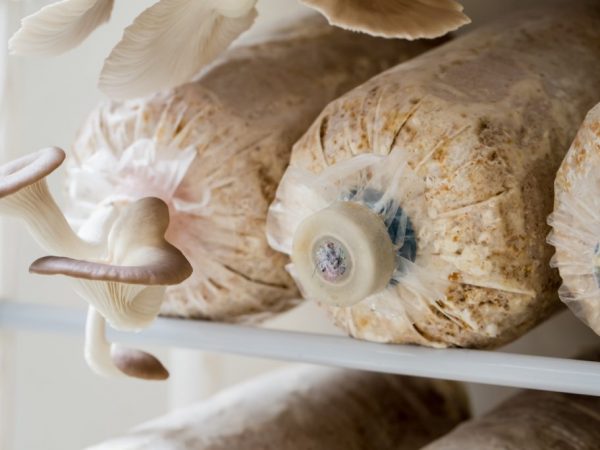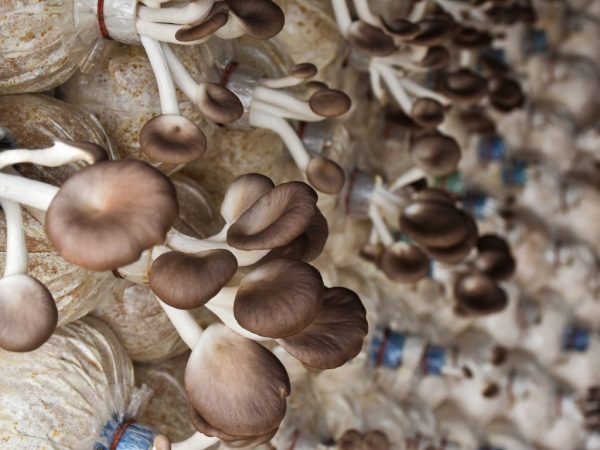Growing oyster mushroom mycelium at home
It is easy to grow mushrooms at home if there are appropriate conditions and high-quality planting material. To obtain the latter mycelium, oyster mushrooms are bred with their own hands at minimal cost. This time-consuming but simple process is suitable even for novice mushroom growers.

Oyster mushroom mycelium making
Features of the mycelium
Oyster mushroom mycelium, or mycelium, is, like all cap mushrooms, the vegetative part of the mushroom body. It is formed by filamentous processes that envelop the substrate and provide it with nutrition. The appearance of a fungus familiar to us is the final stage in the development of the mycelium. He himself occupies a larger area than the fruiting body visible to the eye.
Do-it-yourself oyster mushroom mycelium practically does not differ from the one that produces mushrooms in the wild on stumps. The only difference is an improvement in the quality of the starting material, an increase in the survival rate of the fungus. On the territory of Russia, the practice of growing oyster mushrooms at home with minimal support for the emerging mycelium is widespread.
Preparation for growing
In the modern world, artificial breeding of mycelium is practiced in laboratories in mushroom production. This practice protects the planting material from the penetration of pathogenic viruses and the development of diseases. The industrial scale has led to a deterioration in the quality of the dry product, which is sold in stores and is ready for breeding. People prefer to get oyster mushroom mycelium at home and store it in special places.
Preparation for the process requires compliance with certain conditions:
- the presence of laboratory instruments - tweezers, a burner, several small containers, test tubes, thermometer, pipette;
- warm room with a stable temperature within 20 ° С and humidity not higher than 75%;
- lack of direct sunlight and drafts;
- regular disinfection of all available materials, as well as hands, tables, walls (medical alcohol is well suited for these purposes);
- the presence of grain, agar, sawdust, mushroom sticks, etc.;
- breeding material for oyster mushrooms.
Step-by-step cultivation
To obtain a full-fledged oyster mushroom mycelium, it is necessary to follow the procedure and maintain a constant temperature regime. Fungi thrive in high humidity and oxygen-rich conditions. As a result, it will be possible to get a high-quality mycelium, ready for fruiting.
First step
Oyster mushroom spores can be purchased from suppliers, but such material is not always of a high quality. For cultivation, it is better to take one good young mushroom and cut a piece that is closer to the cap. Sometimes the leg is cut at the base into thin long strips.
Before use, oyster mushrooms are placed in 3% hydrogen peroxide, which disinfects and kills parasites.
Next, prepare the material for planting the mycelium:
- It will be possible to make oyster mushroom grain mycelium based on barley, wheat, oats after preliminary preparation.To do this, choose only high-quality crops (you will have to sort out the grain by hand), grind them or use husks. A piece of mushroom is placed in a disinfected test tube, tightly closed with a lid.
- The basis can be potato-glucose, carrot, oat agar. It is pre-sterilized in test tubes, cooled to room temperature at maximum inclination. So the growing mycelium will take up a large area.
- When growing mycelium on cardboard, clean corrugated material without inscriptions is used. It is soaked in water, after an hour the leftovers are decanted. Pieces of the mushroom are placed around the entire perimeter, covered with torn off top layers of a cardboard sheet. The container with the contents is periodically moistened and ventilated.
Irina Selyutina (Biologist):
To grow mycelium, you can make your own nutrient medium. There are many known options for it, but the following types are most often used:
- Oat agar: 1 liter of water, 75 g of oat flour, 17 g of agar-agar. Flour in a deep bowl is mixed with 500 ml of water (so that there are no lumps) and heated for 1 hour in a water bath. Then filter. Agar-agar is dissolved in the remaining 500 ml of hot water and combined with oat broth.
- Potato Glucose Agar: 1 l of water, 200 g of peeled potatoes, 20 g of glucose, 17 g of agar-agar. Cut the potatoes and boil for 2 hours in 500 ml of water. Dissolve agar-agar in a second volume of water (500 ml) - it must be hot. Then strain the broth into agar-agar, add glucose and mix.
- Wort agar: 800 ml water, 200 ml unhopped beer wort, 20 g agar-agar. Dilute the wort in 400 ml of water. Pour the agar-agar into hot water (400 ml), cool slightly and combine with the dissolved wort.
The finished mixture is poured into a container for 1 / 2-3 / 4 of the volume, sterilized and the dishes are placed at an angle to the horizontal surface in order to obtain a large area for inoculation. When the base hardens, the dishes are returned to their original - vertical position. The neck must be closed with a cotton-gauze stopper.
After planting, the tubes are stored in a dark room at a temperature of 24 ° C. It takes 24 to 60 days to germinate the mycelium and develop the filaments. They look like a white fluffy bloom on the planting material. Determine the viability of the mycelium by the pleasant smell of fresh mushrooms.
Second phase

Growing oyster mushrooms at home is widespread in Russia
The intermediate mycelium uses a lot of material for its growth. The most convenient option is to plant in grain. To multiply the seed, only one type of crop is selected. The combination of cereals of different varieties threatens the occurrence of fermentation and the death of the source material. The grain is boiled in water with a change of liquid for 15-30 minutes.
It is dried, keeping 75% moisture content, mixed with calcium carbonate, lime or gypsum.
The intermediate oyster mushroom mycelium at home is obtained by observing a clear sequence of such actions:
- the grain substrate is poured into transparent containers - cans or bottles, filling them by 2/3 and sterilized for 1-2 hours;
- after cooling, the previously grown material is placed on top;
- closed with a lid with a hole covered with cotton wool;
- containers are regularly ventilated to release carbon dioxide;
- it is better to store containers in a dark place at a temperature of 20 ° C for 2-3 weeks until the mycelium is fully germinated.
Do-it-yourself grain material with mycelium is suitable for further use as breeding. If there is a lot of it, a part is separated and left for some time. In industrial production, freezing with liquid nitrogen is used. For your information. At home, it is allowed to store oyster mushroom mycelium in a freezer at –20 ° С for no longer than 3 months. After thawing, the mycelium quickly resumes and is ready for planting.
Please note that repeated sudden temperature changes will kill the mushroom material.
Stage Three
At this stage, the planting material is prepared for the final stage - mushroom growing. For these purposes, they choose an enclosed space - a garage, a shed or a storage room. It maintains a temperature of 15-20 ° C and humidity up to 85-90%. It is required to take care of mushrooms so that they are in conditions of constant access to oxygen and release of carbon dioxide. Daylight hours should last at least 9 hours, but without the penetration of direct sunlight into the room.
Substrates such as sawdust, cardboard, and straw have proven themselves well. They are poured into large long bags or bags. The production of oyster mushrooms in such blocks is simpler, and their placement saves space. Deciduous tree stumps are also excellent for these purposes.
At home, the uterine mycelium is planted in bags, following the following procedure for filling:
- 1 kg of substrate is poured onto the bottom, sprouted oyster mushroom mycelium is added, leveled;
- the procedure is repeated until the bag is filled.
Please note that a better exit of fruit bodies to the surface, the mother material is tried to be placed as close as possible to the walls of the container. For maximum effect, the amount of substrate and seed mycelium is 1: 0.05, the total weight reaches 13-15 kg.
Irina Selyutina (Biologist):
When choosing a basement for growing oyster mushrooms, keep in mind that the air humidity in it will be directly related to the dryness of this room. If it is regularly heated with groundwater, it will be very difficult to maintain the required humidity level. First, you will have to solve the problem of the tightness of the room and only after that transfer the blocks for growing there.
Content blocks are suspended from the ceiling or placed on a shelf. To ensure aeration, the walls of the bags are necessarily cut in several places. The holes should be small, within 3-5 cm. To maintain the humidity level, water is regularly sprayed until the first mushrooms appear.
Conclusion
Breeding oyster mushroom mycelium at home will require a significant amount of time and absolute patience. It is important to follow the recommendations and prevent the development of mold. If an infection is detected, the substrate with the planting material is left for a day under a quartz lamp. With due diligence and a serious approach, the result will be a rich harvest.


